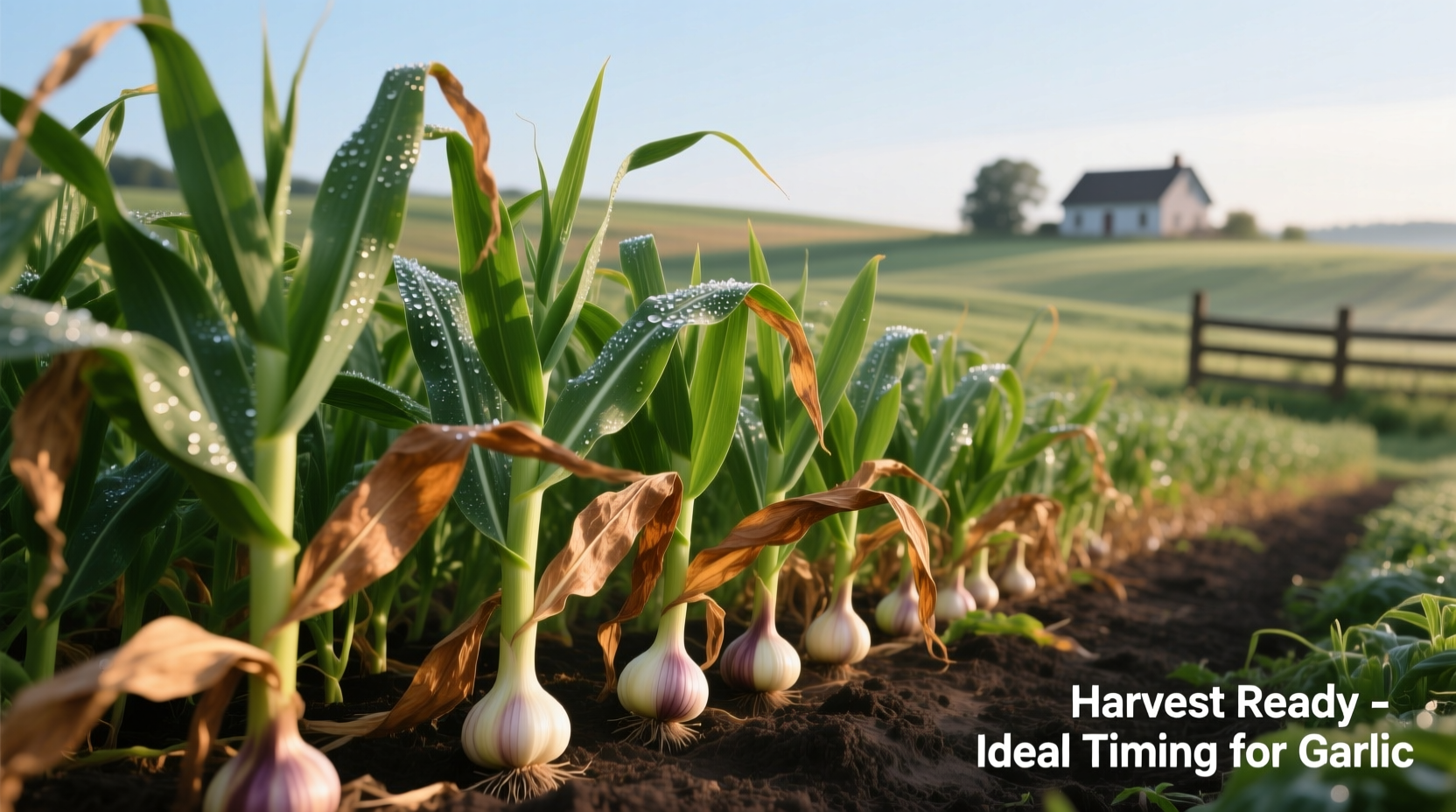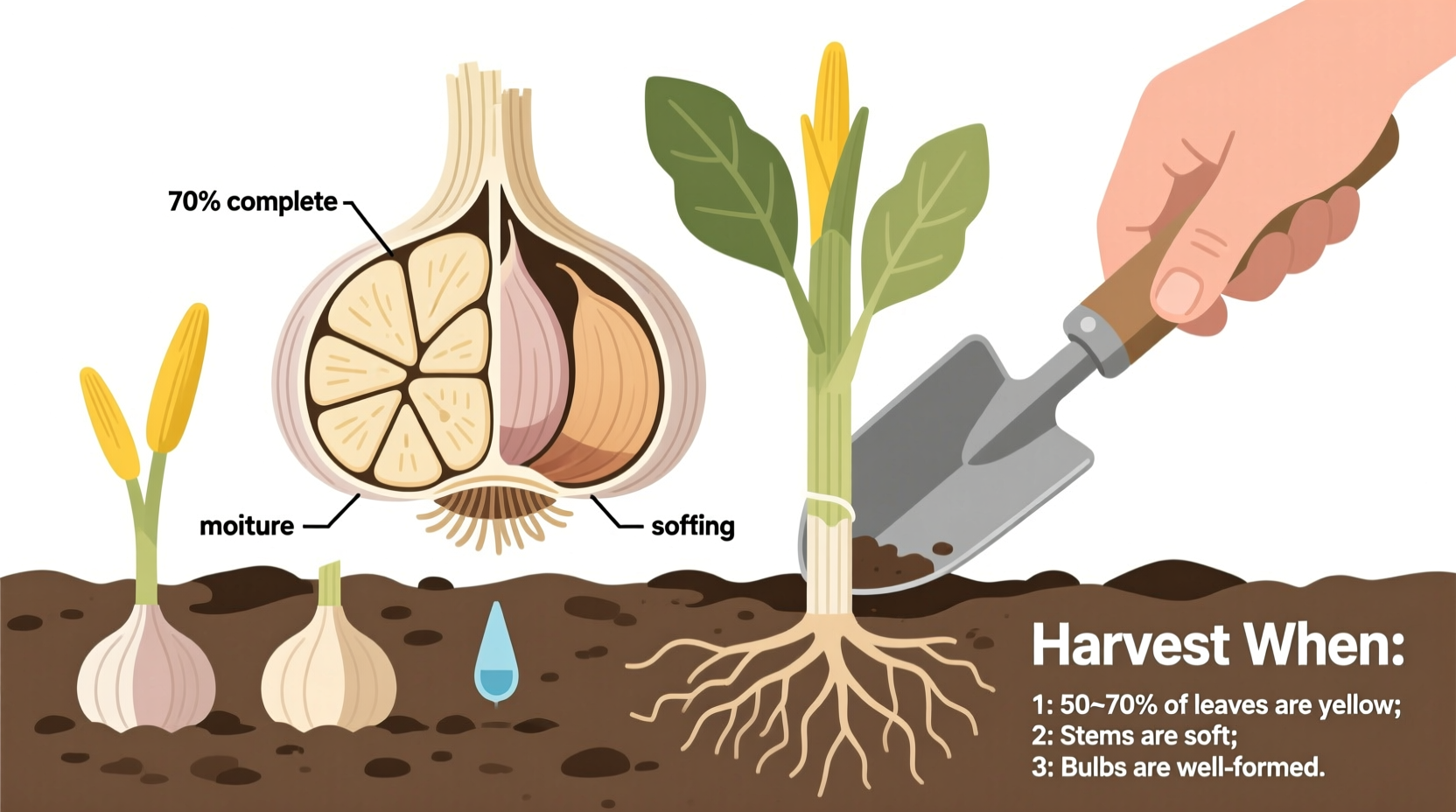Getting the harvest timing right makes all the difference between garlic that stores for months and bulbs that deteriorate quickly. Harvest too early, and you'll get small cloves with thin wrappers that don't store well. Wait too long, and the bulbs may split open, inviting rot and reducing shelf life. The perfect harvest window varies slightly by garlic type and climate, but reliable visual cues work universally.
Key Visual Indicators for Garlic Harvest Readiness
While calendar dates provide a general guideline, these visual indicators give you precise harvest timing:
- Leaf color transition - When the lower third to half of leaves turn brown while the upper portion remains green
- Bulb wrapper condition - The papery outer layers should be intact and relatively tight (check one bulb by gently brushing soil away)
- Clove definition - Individual cloves should be clearly defined but not pushing through the wrapper
- Soil surface cracks - In some varieties, the soil around mature bulbs develops characteristic radial cracks
According to research from the Oregon State University Extension Service, the leaf color indicator provides the most reliable harvest signal across different garlic varieties and growing conditions. The plant naturally redirects energy from leaves to bulb development as harvest approaches.
| Garlic Variety | Typical Harvest Window | Leaf Color Indicator | Special Considerations |
|---|---|---|---|
| Softneck (Artichoke) | Early to mid-summer | 40% brown, 60% green | Harvest earlier than hardnecks; more flexible harvest window |
| Softneck (Silverskin) | Late spring to early summer | 30-40% brown | Smaller bulbs; harvest when 5-6 leaves remain green |
| Hardneck (Rocambole) | Mid to late summer | 50% brown, 50% green | Watch for scape removal effects on timing |
| Hardneck (Porcelain) | Late spring to early summer | 40% brown, 60% green | Larger bulbs; harvest slightly earlier than other hardnecks |
Regional Timing Variations Across North America
Garlic harvest timing varies significantly by climate zone. The leaf color indicator remains consistent, but calendar dates shift:
- Northern regions (USDA zones 3-5): Harvest typically occurs June-July for hardnecks, July-August for softnecks
- Midwestern regions (zones 5-7): Harvest window is generally late June through July
- Southern regions (zones 7-9): Softnecks harvested May-June; hardnecks often struggle in warmer climates
- Coastal regions: Harvest may be 2-3 weeks later than inland areas at similar latitudes
The Old Farmer's Almanac notes that garlic planted in fall typically matures 7-8 months later, while spring-planted garlic matures in 4-5 months. In warmer climates, some gardeners plant in late winter for early summer harvest.

Step-by-Step Harvesting Process
Once you've confirmed your garlic is ready using the visual indicators, follow these steps for optimal results:
- Choose the right day - Harvest during dry weather after several rain-free days for easier soil work
- Loosen the soil - Use a garden fork to gently lift bulbs from 6 inches away from the stalk
- Lift carefully - Grasp the stalk near the base and pull upward with steady pressure
- Avoid washing - Brush off excess soil but don't wash bulbs (moisture promotes rot)
- Initial inspection - Check 3-5 bulbs from different areas to confirm maturity
According to Cornell University's Department of Horticulture, harvesting during the morning hours when temperatures are cooler helps preserve bulb quality. Never yank garlic from the ground by the leaves, as this can damage the neck and compromise storage potential.
Common Harvest Mistakes and Their Consequences
Understanding what happens when harvest timing is off helps reinforce why precision matters:
- Harvesting too early (more than 70% green leaves):
- Smaller bulb size with underdeveloped cloves
- Thin, fragile wrappers that offer poor protection
- Reduced storage life (typically 1-2 months instead of 6-9)
- Harvesting too late (more than 60% brown leaves):
- Bulbs may split open, exposing cloves to disease
- Outer wrappers deteriorate, reducing storage capability
- Cloves may begin to regrow, creating a "heart" in the center
Post-Harvest Curing Process
Proper curing directly impacts storage longevity. Follow these steps after harvest:
- Dry in shade - Place garlic in a single layer on screens or hang in bundles in a dry, shaded, well-ventilated area
- Maintain conditions - Ideal curing environment: 75-85°F with 60-75% humidity for 2-3 weeks
- Monitor progress - Curing is complete when outer wrappers are papery and necks are fully dry
- Trim carefully - Cut roots to ¼ inch and stems to 1-2 inches after curing completes
- Store properly - Keep in mesh bags or baskets in a cool (55-65°F), dark place with good air circulation
The University of Minnesota Extension emphasizes that proper curing transforms garlic from a living plant product to a stable food item. Skipping or rushing this process significantly reduces storage potential regardless of perfect harvest timing.
Special Considerations for Different Garlic Types
While the basic harvest indicators apply universally, these variety-specific considerations help optimize results:
- Hardneck varieties - Harvest scapes 2-3 weeks before bulb maturity to redirect energy to bulb development
- Elephant garlic - Despite the name, this is actually a leek relative with different timing (harvest when 50% of leaves yellow)
- Spring-planted garlic - Typically matures faster than fall-planted; watch leaf color closely as calendar dates vary widely
- Container-grown garlic - May mature slightly earlier due to warmer root zone temperatures
When to Adjust Your Harvest Timing
Certain conditions require modifying standard harvest practices:
- Heavy rainfall before harvest - Harvest immediately if possible to prevent bulbs from splitting
- Extreme heat waves - May accelerate maturity; check plants daily during heat events
- Pest pressure - If root maggots or other pests are present, harvest slightly early to save the crop
- Disease issues - With fungal diseases, harvest early and use bulbs quickly rather than storing
Remember that garlic continues to develop even after you stop watering. The Oregon State University Extension recommends ceasing irrigation 2-3 weeks before expected harvest to begin the natural drying process.
Frequently Asked Questions
How do I know if I've harvested my garlic too early?
If your garlic bulbs have thin, papery wrappers that tear easily and the cloves don't fill the wrapper completely, you likely harvested too early. Early-harvested garlic typically stores for only 1-2 months rather than the 6-9 months of properly timed harvests. The cloves will feel less firm and may have a milder flavor profile.
Can I harvest garlic when all the leaves have turned brown?
Harvesting when all leaves have turned brown usually means you've waited too long. At this stage, bulbs often split open, exposing cloves to disease and reducing storage life. The protective wrappers deteriorate, making bulbs vulnerable to mold. If you notice fully brown foliage, harvest immediately to save what you can, but expect reduced storage potential.
Should I wash garlic after harvesting?
No, you should not wash garlic after harvesting. Washing introduces moisture that can promote rot during curing and storage. Instead, gently brush off excess soil while the bulbs are still in the field. If needed, you can lightly wipe particularly dirty bulbs with a dry cloth after curing is complete, but avoid getting the bulbs wet.
How long should I cure garlic before storing?
Garlic typically requires 2-3 weeks of curing in a warm, dry, well-ventilated location. Properly cured garlic will have dry, papery outer wrappers, completely dry necks, and roots that are brittle to the touch. The curing process is complete when you can easily brush off the outer wrappers without damaging the cloves beneath.
What's the best way to store harvested garlic?
Store cured garlic in a cool (55-65°F), dark location with good air circulation. Mesh bags, wire baskets, or braided strands work well. Avoid plastic bags or airtight containers, which trap moisture. Softneck varieties typically store longer (9-12 months) than hardnecks (6-8 months). Never store garlic in the refrigerator, as the humidity promotes sprouting.











 浙公网安备
33010002000092号
浙公网安备
33010002000092号 浙B2-20120091-4
浙B2-20120091-4